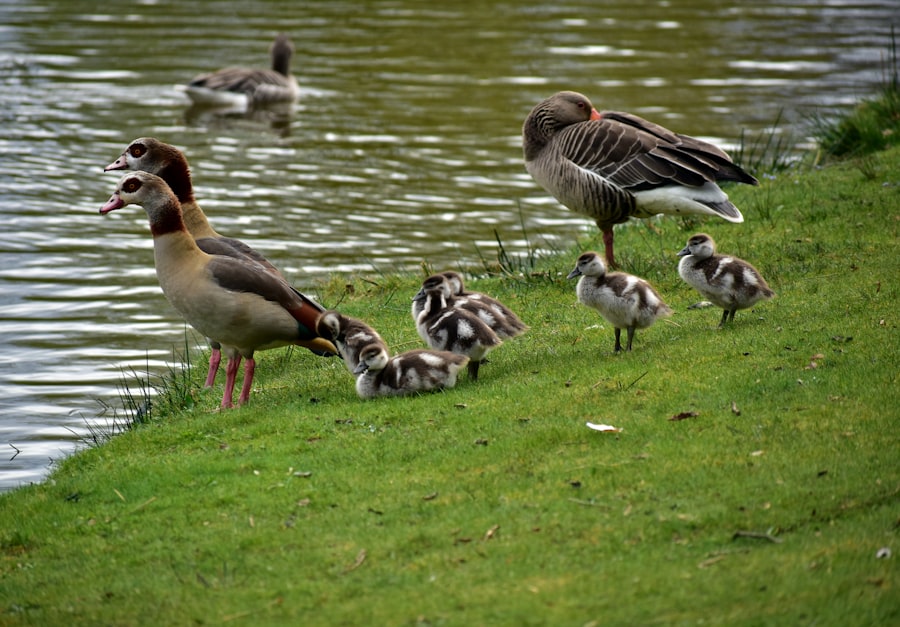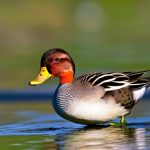Small duck breeds have a long history and have been bred for various purposes throughout the years. They are becoming increasingly popular among hobbyists and farmers for several reasons. These ducks are known for their compact size, friendly temperament, and excellent egg-laying capabilities.
Small duck breeds have been around for centuries, with some breeds originating in Asia and others in Europe. They were initially bred for their meat and eggs, but over time, they have also become popular as pets and show birds. Today, small duck breeds are enjoyed by people all over the world for their unique characteristics and versatility.
The popularity of small duck breeds can be attributed to their manageable size and lower maintenance requirements compared to larger duck breeds. They are easier to handle and care for, making them ideal for small-scale farming or backyard enthusiasts. Additionally, their smaller size means they require less feed and housing space, making them more cost-effective to raise.
Key Takeaways
- Small duck breeds are becoming increasingly popular among backyard farmers and homesteaders.
- Understanding the characteristics of small duck breeds is important for choosing the right breed for your needs.
- Popular small duck breeds include the Call, East Indie, and Silver Bantam.
- Raising small duck breeds can provide benefits such as pest control and egg production.
- Best practices for housing and feeding small duck breeds include providing adequate space and a balanced diet.
Understanding the Characteristics of Small Duck Breeds
Small duck breeds differ from larger duck breeds in several ways. Firstly, they are significantly smaller in size and lighter in weight. While larger duck breeds can weigh up to 10 pounds or more, small duck breeds typically weigh between 2-5 pounds. This makes them easier to handle and less intimidating for those who may be new to raising ducks.
In terms of temperament and behavior traits, small duck breeds are known for being friendly and sociable. They are generally less aggressive than larger duck breeds and can be easily tamed with proper handling and socialization. This makes them great pets for families or individuals looking for a companion animal.
When it comes to egg-laying capabilities, small duck breeds excel in this area. They are known for their high egg production, often laying between 150-200 eggs per year. This makes them a popular choice for those interested in raising ducks for their eggs. The eggs of small duck breeds are typically smaller in size compared to larger duck breeds, but they are still delicious and nutritious.
Popular Small Duck Breeds: A Comprehensive List
There are several popular small duck breeds that are loved by enthusiasts and farmers alike. Each breed has its own unique characteristics and traits that make them special. Here is a brief description of some of the most popular small duck breeds:
1. Call Ducks: Call ducks are one of the smallest duck breeds, weighing only 1-2 pounds. They have a distinctive appearance with a compact body, short bill, and upright posture. Call ducks are known for their loud and distinctive quack, which is how they got their name. They come in various colors and patterns, making them a favorite among duck breeders and exhibitors.
2. Indian Runner Ducks: Indian Runner ducks are known for their upright stance and slender body shape. They have a unique way of walking, almost resembling a penguin. Indian Runners come in a variety of colors, including white, black, fawn, and chocolate. They are excellent egg layers, producing up to 200 eggs per year.
3. Khaki Campbell Ducks: Khaki Campbell ducks are a British breed known for their excellent egg-laying capabilities. They have a khaki-colored plumage and a slender body shape. Khaki Campbells are highly productive layers, often producing over 300 eggs per year. They are also known for their calm and friendly temperament.
4. Miniature Appleyard Ducks: Miniature Appleyard ducks are a smaller version of the popular Appleyard breed. They have a compact body shape and come in various colors, including silver, gold, and blue. Miniature Appleyards are known for their friendly and docile nature, making them great pets or show birds.
5. Swedish Blue Ducks: Swedish Blue ducks are known for their beautiful blue plumage and striking appearance. They have a compact body shape and are excellent foragers. Swedish Blues are known for their calm and friendly temperament, making them a popular choice for backyard enthusiasts.
The Benefits of Raising Small Duck Breeds
There are several benefits to raising small duck breeds, which is why they are becoming increasingly popular among hobbyists and farmers. Here are some of the advantages of raising small duck breeds:
1. Lower feed and housing costs: Small duck breeds require less feed compared to larger duck breeds due to their smaller size. This can result in significant cost savings, especially for those who are raising ducks on a small scale. Additionally, their smaller size means they require less housing space, which can also save on construction and maintenance costs.
2. Easier to handle and care for: Small duck breeds are easier to handle and care for compared to larger duck breeds. Their smaller size makes them more manageable, especially for those who may be new to raising ducks. They are also generally less aggressive and easier to tame, making them great pets or show birds.
3. Potential for profit through egg sales or breeding: Small duck breeds are excellent egg layers, often producing a high number of eggs per year. This presents an opportunity for those interested in selling eggs or breeding ducks for profit. The eggs of small duck breeds are in high demand due to their delicious taste and nutritional value.
Housing and Feeding Small Duck Breeds: Best Practices
Proper housing and feeding are essential for the health and well-being of small duck breeds. Here are some best practices to consider when it comes to housing and feeding small duck breeds:
1. Recommended housing and bedding materials: Small duck breeds require a secure and comfortable housing environment. A sturdy coop or shed with proper ventilation is essential to protect them from predators and extreme weather conditions. Bedding materials such as straw or wood shavings can be used to provide a clean and dry surface for the ducks to rest on.
2. Feeding requirements and recommended diets: Small duck breeds have specific feeding requirements to ensure they receive the necessary nutrients for optimal health. A balanced diet consisting of commercial duck feed, fresh vegetables, and access to clean water is recommended. It is important to avoid feeding them bread or other processed foods, as these can be harmful to their health.
3. Water and swimming needs: Ducks require access to clean water for drinking and bathing. Small duck breeds may not require a large pond or swimming pool like larger duck breeds, but they still need a shallow container or tub of water to splash around in. This helps keep their feathers clean and healthy.
Small Duck Breeds as Pets: What You Need to Know

Small duck breeds can make great pets, but it is important to understand the pros and cons before bringing them into your home. Here are some things you need to know about keeping small duck breeds as pets:
1. Pros of keeping small duck breeds as pets: Small duck breeds are known for their friendly and sociable nature, making them great companions. They can be easily tamed with proper handling and socialization, and many enjoy being around people. They also have unique personalities and can provide entertainment with their antics.
2. Cons of keeping small duck breeds as pets: While small duck breeds can make great pets, there are some challenges to consider. Ducks are messy animals and can create a lot of waste, so proper cleaning and maintenance are necessary. They also require access to water for bathing, which can be messy indoors. Additionally, ducks have specific dietary needs that must be met for optimal health.
3. Tips for socializing and training: Socializing and training your small duck breed is important for their well-being and your enjoyment as a pet owner. Spend time with your ducks regularly, handling them gently and providing positive reinforcement. Ducks can be trained to come when called and even perform simple tricks with patience and consistency.
4. Potential challenges and solutions: Small duck breeds may have specific needs and challenges that pet owners should be aware of. For example, they may require a secure outdoor space to roam and forage, which can be challenging for those living in urban areas. Solutions may include creating a secure outdoor enclosure or finding a suitable alternative such as supervised free-ranging.
Health Issues and Concerns for Small Duck Breeds
Like any animal, small duck breeds can be prone to certain health issues and concerns. It is important to be aware of these and take appropriate measures to prevent them. Here are some common health issues and how to address them:
1. Common health issues and how to prevent them: Small duck breeds can be susceptible to respiratory infections, parasites, and nutritional deficiencies. Providing a clean and well-ventilated housing environment, regular deworming, and a balanced diet can help prevent these issues. It is also important to monitor your ducks for any signs of illness or distress.
2. Signs of illness and when to seek veterinary care: It is important to be able to recognize the signs of illness in your small duck breed so that you can seek veterinary care if necessary. Signs of illness may include lethargy, loss of appetite, difficulty breathing, or changes in behavior. If you notice any of these signs, it is best to consult with a veterinarian who specializes in avian care.
3. Vaccination and parasite prevention recommendations: Vaccinations are not typically required for small duck breeds, but it is important to consult with a veterinarian to determine if any vaccinations are recommended based on your specific location and circumstances. Regular deworming and parasite prevention measures should also be implemented to keep your ducks healthy.
Breeding Small Duck Breeds: Tips and Techniques
Breeding small duck breeds can be a rewarding experience, but it requires careful planning and preparation. Here are some tips and techniques for breeding small duck breeds:
1. Recommended breeding age and practices: Small duck breeds can start breeding as early as 6-8 months of age, but it is generally recommended to wait until they are at least 1 year old to ensure they are fully mature. Breeding pairs should be selected based on their health, temperament, and conformation to breed standards.
2. Incubation and hatching tips: If you plan to incubate the eggs yourself, it is important to have a reliable incubator and follow the manufacturer’s instructions. Duck eggs typically take around 28 days to hatch, but this can vary depending on the breed. Proper temperature and humidity levels are crucial for successful hatching.
3. Caring for ducklings: Once the ducklings hatch, they require special care and attention. They should be kept in a warm and secure brooder with access to clean water and a balanced diet. It is important to monitor their health and provide appropriate veterinary care if needed.
Small Duck Breed Shows and Competitions: What to Expect
Small duck breed shows and competitions are a great way to showcase your ducks and connect with other enthusiasts. Here is an overview of what to expect at small duck breed shows:
1. Overview of small duck breed shows and competitions: Small duck breed shows are events where breeders and exhibitors come together to showcase their ducks. Ducks are judged based on their conformation to breed standards, temperament, and overall appearance. These events often include various classes and categories for different breeds.
2. Judging criteria and standards: Judges evaluate ducks based on specific criteria outlined in the breed standard for each breed. This includes factors such as body shape, feather quality, coloration, and overall health. Ducks that closely match the breed standard are awarded higher scores.
3. Tips for preparing and showing your ducks: To prepare your ducks for a show, it is important to groom them properly. This includes bathing them, trimming their feathers if necessary, and ensuring they are in good health. It is also important to practice handling and posing your ducks so that they are comfortable and cooperative during the show.
Is a Small Duck Breed Right for You?
In conclusion, small duck breeds offer a range of benefits and challenges for those interested in raising ducks. They are becoming increasingly popular among hobbyists and farmers due to their manageable size, friendly temperament, and excellent egg-laying capabilities. However, it is important to consider the specific needs and requirements of small duck breeds before bringing them into your home.
If you are looking for a low-maintenance and cost-effective option, small duck breeds may be the right choice for you. They require less feed and housing space compared to larger duck breeds, making them more affordable to raise. They are also easier to handle and care for, making them great pets or show birds.
When choosing a small duck breed, consider factors such as size, temperament, egg-laying capabilities, and your specific needs and preferences. Research different breeds and consult with experienced breeders or farmers to determine which breed is the best fit for you.
Overall, small duck breeds can bring joy and companionship to your life while also providing the opportunity for profit through egg sales or breeding. With proper care and attention, these ducks can thrive and become beloved members of your family or farm.
If you’re interested in small duck breeds, you might also want to check out this informative article on Poultry Wizard about keeping guinea fowl with chickens. It discusses whether guinea fowl can live harmoniously with chickens and provides valuable insights for poultry enthusiasts. For more helpful resources on poultry keeping, visit Poultry Wizard’s website. Additionally, if you’re looking for a reliable chicken coop, the SnapLock Chicken Coop featured on their site is worth considering.
FAQs
What are small duck breeds?
Small duck breeds are domesticated ducks that are smaller in size compared to other duck breeds. They are usually kept as pets or for ornamental purposes.
What are some examples of small duck breeds?
Some examples of small duck breeds include Call ducks, Mandarin ducks, Wood ducks, and Carolina ducks.
What is the average size of small duck breeds?
The average size of small duck breeds is around 1-2 pounds in weight and 12-15 inches in length.
What is the lifespan of small duck breeds?
The lifespan of small duck breeds can vary depending on the breed and their living conditions. On average, they can live up to 10-15 years.
What is the temperament of small duck breeds?
Small duck breeds are generally friendly and social. They can be trained to be comfortable around humans and can make great pets.
What is the diet of small duck breeds?
Small duck breeds require a diet that is high in protein and low in carbohydrates. They can be fed a combination of commercial duck feed, fresh vegetables, and fruits.
What is the housing requirement for small duck breeds?
Small duck breeds require a shelter that is safe, dry, and well-ventilated. They also need access to water for swimming and drinking.
What are the common health issues of small duck breeds?
Common health issues of small duck breeds include respiratory infections, parasites, and injuries. It is important to provide them with proper care and regular veterinary check-ups to prevent and treat any health issues.
Meet Walter, the feathered-friend fanatic of Florida! Nestled in the sunshine state, Walter struts through life with his feathered companions, clucking his way to happiness. With a coop that’s fancier than a five-star hotel, he’s the Don Juan of the chicken world. When he’s not teaching his hens to do the cha-cha, you’ll find him in a heated debate with his prized rooster, Sir Clucks-a-Lot. Walter’s poultry passion is no yolk; he’s the sunny-side-up guy you never knew you needed in your flock of friends!







